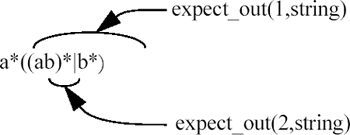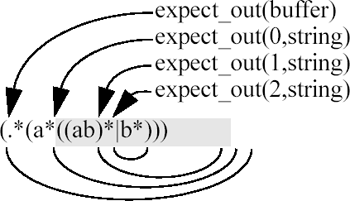Nested Parentheses
The pattern a*((ab)*|b*) has nested parentheses. How are the results stored in the array expect_out? They are determined by counting left parentheses: the subexpression which starts with the Nth left parenthesis corresponds with expect_out(N,...). For example, the string that matches ((ab)*|b*) is stored in expect_out(1,string), and the string that matches (ab) is stored in expect_out(2,string). Of course, the only string that could possibly match "ab" is "ab“. If you want to record the string of ab’s that corresponds to (ab)* then you have to put another pair of parentheses around that, as in "((ab)*)“.

Figure 5-1. Strings that match parenthesized subpatterns are stored in the expect_out array
The string matched by the whole pattern is stored in expect_out(0,string). This makes sense if you imagine the whole pattern is wrapped in another set of parentheses. And you can also imagine the whole pattern prefaced by a .* pattern[23] and wrapped in yet another pair of parentheses to determine the value of expect_out(buffer).

Figure 5-2. The original pattern is shaded. Text that matches the imaginary pattern (.*(...)) is stored in expect(0,string) and expect_out(buffer).
[23] Unlike the usual meaning of .* which matches as many characters as possible, this imaginary .* matches ...
Get Exploring Expect now with the O’Reilly learning platform.
O’Reilly members experience books, live events, courses curated by job role, and more from O’Reilly and nearly 200 top publishers.

